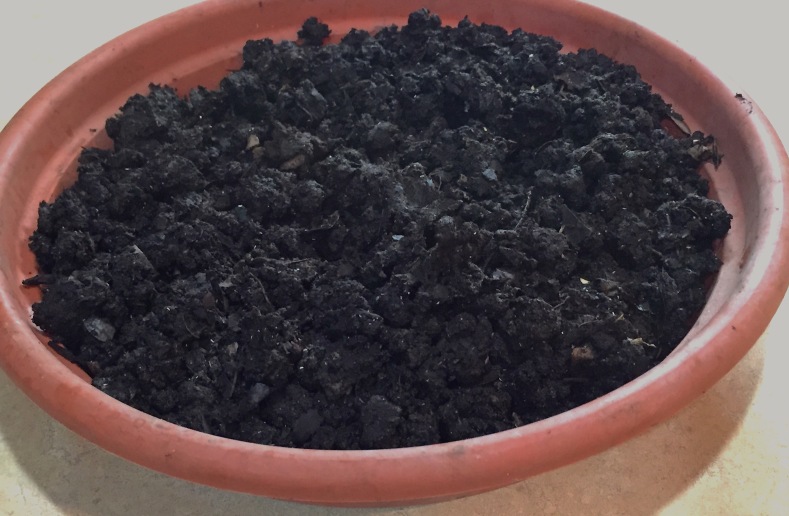Yesterday it was time to reap some rewards from all the work my ambitious red wiggler friends have been doing for the last three months. It’s not a quick process. Mind-numbingly tedious, some might call it. There’s probably a better way. But I don’t mind at all.
A few weeks before harvest time, I cut back their food and entice them to one end of the bin with incentives; cornmeal in this case. Then, when it’s time, I sift through the other end, carefully checking for worms, and setting aside the precious castings made from nothing more than our kitchen scraps and shredded paper. My method looks like this:
And I always make sure my wife is gone before delving in. What she don’t know won’t hurt her. It’s frankly a mess. But so worth it. I’m good at cleaning up in some circumstances.
I only use a couple of handfuls of vermicompost to make 5 gallons of tea, enough to spray my whole garden, with plenty left over for the flowers or planting holes or homemade potting mix. I stockpile castings through the winter in a 5 gallon bucket with the lid slightly ajar, to keep the microbes and geegaws that make it so good supplied with air so they can continue to do their thing.
And I’ll repeat what I said to myself earlier out loud. ‘Holy crap, there’s a lot of worms’. Might have to expand to two bins. Maybe even try an outside bin if my experiment shows any promise.
It’s the best thing in life to love what you do.



Very nice!
In our community vermicomposting method (Bangalore), we place cow dung balls at the bottom of the pile. Most of the worms, especially small ones, get attracted to its smell and leave the pile. Before sieving, we just take out the dung balls filled with worms first and put them into an already prepared pile and take out the remaining through sieving. Otherwise, it’s impossible to save the worms when the quantity at hand is in 100s of kgs.
I have also tried making a heap in a well-lit area and the worms automatically settle at the bottom. That also works.
Happy composting, Dan… 🙂
LikeLiked by 2 people
What a great idea Savita! I bet horse dung would work equally well, so I’ll have to give that a try. Generally how long does it take before the worms have migrated enough to be able to harvest? I’ve tried the light piles before, and that works pretty well. But I don’t mind sifting by hand either. 🙂
LikeLiked by 1 person
We place the dung at least a week before. Fresh dung works better than old/dry one.
Sifting by hand is fun. But becomes quite a task when the quantity is high.
LikeLike
We did this for a while, but with everything we had going on, I just lost time to take care of the “tedious” task. We do still use a compost tumbler and also compost over winter directly in our raised garden beds.
LikeLiked by 1 person
All compost is good stuff! I know that harvesting worm castings isn’t for everyone. Glad you can make use of what works for you. And thanks for reblogging!
LikeLiked by 2 people
Reblogged this on Save Green Going Green.
LikeLike
Good ideas. And, making sure the wife is gone is often the first step to success for messy sorts of projects 🙂
LikeLiked by 3 people
Spoken with true wisdom.
LikeLiked by 2 people
Reblogged this on Permaculture Northwest Ohio and commented:
I found this from Vegetablurb on more advanced winter composting than my own!
LikeLike
I wishi lived closer .. I need to get some worms! Love the little wrigglies ..
LikeLiked by 1 person
I hope you can find a way Julie. But if you lived closer, it’d be more likely you’d be freezing your head off and shovelling snow than harvesting veggies right now!
LikeLiked by 1 person
Ah a quick change of heart .. I’ll stay put! 🙂
LikeLike
if you have a local classified online, you can post to sell or give away half the worms. with my wigglers, and my kefir cultures – both which grow – I can always find a ready home.
LikeLiked by 1 person
That’s a good idea Melissa. I might try getting someone I know interested in worms too. Evangelize.
LikeLiked by 1 person
Even though I realize I’m reading this a little late, I still think it’s neat that I came across this post on the same day that I just did the same thing with my bins, and I had the exact same thought, except since I’m already starting with two bins, I’m going to have to find some good friend who would like to start a bin. I think 4 bins in my little apartment would be getting just a little tight. 😉
LikeLiked by 1 person
But what a good problem to have.
LikeLike